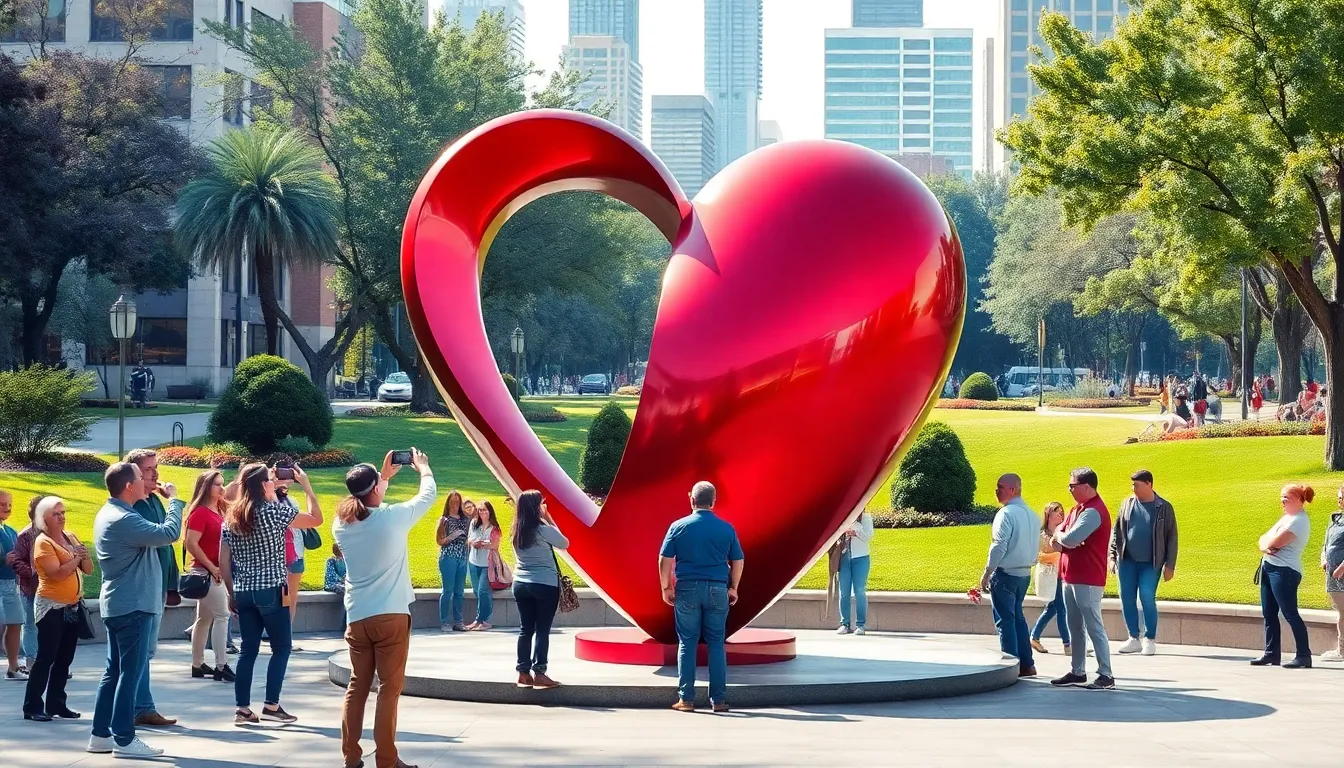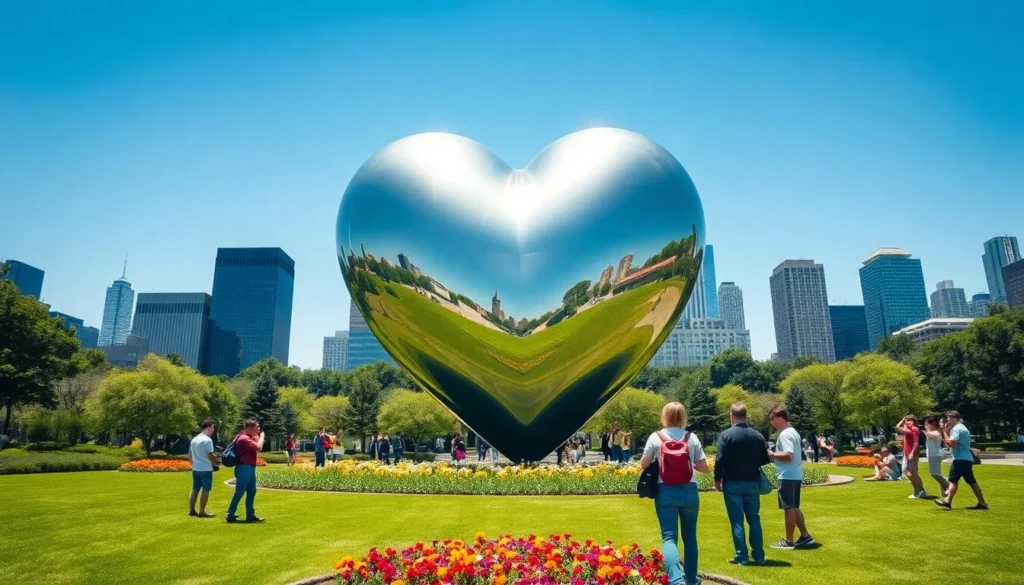Table of Contents
ToggleHeart sculptures aren’t just for romantics or art buffs: they’re for anyone who appreciates the intersection of emotion and aesthetics. Imagine strolling through a park and being greeted by a colossal heart art piece. You’d probably stop, snap a picture, and reflect on love in its many forms. These stunning creations are more than just pretty shapes, they encapsulate feelings, histories, and cultures. By diving into the world of heart sculptures, one uncovers a rich tapestry woven from creativity, craftsmanship, and significance. So grab your favorite cozy blanket and let’s explore this captivating subject.
The History of Heart Sculptures

The roots of heart sculptures can arguably be traced back to ancient civilizations. In various cultures, the heart was often seen as the epicenter of emotions and intellect. The Egyptians believed that the heart was the key to the afterlife, while the Greeks often associated it with love and passion. Over centuries, artists began carving hearts into stone or wood, evolving them into symbols of affection.
During the Renaissance, heart imagery flourished, marking both romantic and religious expression. Artists frequently depicted hearts in paintings and sculptures, illustrating themes of love and devotion. Fast-forward to the contemporary era, and heart sculptures have become a popular motif in public art installations, often symbolizing hope and unity.
Across time, the evolving representation of the heart illustrates humanity’s shifting perceptions of love and connection. It invites contemplation about what love truly means and how we as a collective express it through art.
Cultural Significance of Heart Sculptures
Heart sculptures resonate deeply across cultures. In many societies, they symbolize love, a theme universally cherished. For example, in Italian culture, heart-shaped motifs often appear during festivals and celebrations of affection. China’s symbolic use of hearts extends to weddings, where they represent the union of two souls.
Beyond love, heart sculptures also convey broader messages. In public art, they can symbolize community, connection, or healing. Artists from around the globe use heart designs to promote social causes, advocating for love to conquer hate. In these contexts, the heart morphs from a simple shape into a potent emblem of hope and resilience.
From intricate carvings to massive installations, these heart sculptures serve as cultural touchstones, compelling observers to meditate on the complexities of love and collective experience.
Materials and Techniques Used in Heart Sculpture
Heart sculptures come in an array of materials, each bringing its unique character to the piece. Artists often choose metal, stone, wood, or glass based on the desired aesthetic and message.
Metal offers durability and a modern aesthetic, perfect for public installations. Stainless steel, when polished, creates a reflective surface that captures its surroundings, inviting viewers to engage with the art physically and emotionally.
Stone, on the other hand, embodies timelessness. Sculptors often select marble or granite for their solidity and natural beauty. The intricate carvings can leave onlookers in awe, as they admire the artist’s skill in shaping such heavy materials into something so emotional.
Wood provides warmth, allowing the heart sculpture to resonate more personally. Artists can manipulate it easily, achieving a softer, more organic feel that encourages connection.
Finally, glass heart sculptures bring a delightful play of light, making them enchanting in the right setting. The translucence and color variations add depth, inviting viewers to think deeper about the themes of love and fragility that the heart conveys.
Each material carries a story, offering different interpretations of the heart’s message, making them rich subjects for study and appreciation.
Notable Heart Sculptures Around the World
Across the globe, countless heart sculptures stand as relics of love and artistry. In New York City, the iconic “Love” sculpture by Robert Indiana captures the essence of the word in a bold, block-letter design. It’s a straightforward yet powerful statement that has transformed into a global symbol of love.
Traveling to India, the heart-shaped “Amar Jawan Jyoti” is an eternal flame honoring the soldiers who have sacrificed their lives. It serves as a reminder that love can be expressed through acts of courage and valor.
Heading across the Atlantic, the heart sculptures in Rio de Janeiro, often featured during the famous carnival, embody the city’s vibrant spirit and passion for life. These installations draw both locals and tourists eager to engage with their heartfelt message.
From public parks to gallery displays, each of these notable heart sculptures weaves its narrative, showcasing the diverse ways love can be symbolized through artistic expression.
Modern Interpretations of Heart Sculptures
As art evolves, so too do the interpretations of heart sculptures. Contemporary artists are pushing boundaries, reimagining the heart shape to provoke thought and dialogue. Some incorporate technology, using neon lights or digital projections to enhance visual storytelling.
Others experiment with abstraction, distorting the heart shape to convey a multitude of feelings, from heartbreak to joy. This shift encourages viewers to explore the complexities of love, rather than a one-dimensional depiction. The modern heart sculpture often challenges traditional notions, inviting personal reflection on love’s various dimensions.
Social and political themes also permeate modern interpretations. Many artists use heart imagery to address issues like mental health, equality, and environmental concerns, blending artistic expression with advocacy. These multifaceted works embody the evolution of heart sculptures as essential venues for creativity and conversation.
How to Incorporate Heart Sculptures in Your Space
Incorporating heart sculptures into a space can add depth and emotional resonance. Whether it’s a home, garden, or office, these art pieces can function as focal points or subtle accents.
For homes, consider placing a smaller heart sculpture on a shelf or coffee table. Choose materials that complement the decor. A glass heart sculpture might fit perfectly in a modern or minimalist setting, while a wooden piece could add warmth to a rustic home.
Gardens can benefit tremendously from larger heart installations. Sculptures made from weather-resistant materials can enhance outdoor spaces, creating invitations for contemplation and serenity.
In corporate environments, heart sculptures can symbolize company values such as teamwork and community engagement. Displaying a large installation in a lobby not only beautifies the space but also serves as a conversation starter, allowing clients and visitors to engage with the brand ethos.
Eventually, incorporating heart sculptures is about finding pieces that resonate personally and contextually, enhancing the overall atmosphere.




